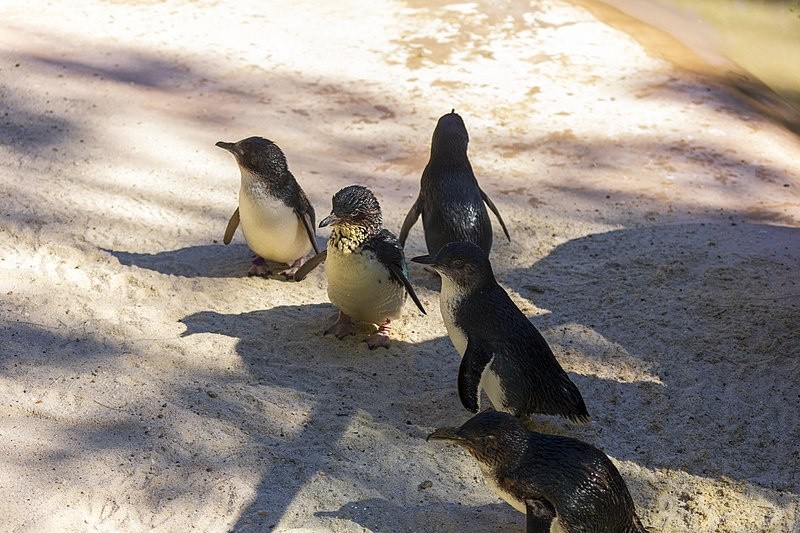As the carcasses of hundreds of tiny blue penguins wash up in New Zealand, search for clues. Conservationists predict mass extinctions will become more common as the climate crisis alters food networks.

The penguins are arranged in neat, precisely spaced rows, their wings spread and their bright blue plumage faded by the sand. There are a total of 183, which were meticulously collected by locals, placed out, and photographed for further research. The birds were discovered last week at Ninety Mile Beach, the latest in a long line of dead penguins washing up on New Zealand shores.
Dead Kororā Penguins
Hi @docgovtnz, 3 dead blue penguins on 90 mile beach today, about 12km north of #Ahipara. All within a 100m stretch of each other. Run over by cars? Or victims of a certain fishing method? #NewZealand #Aotearoa #Wildlife #Penguins@nzherald @NZStuff @Breakfaston1 pic.twitter.com/isuo4OV1Yk
— Jeff Rice (@EvolvingCaveman) May 2, 2022
New Zealand's kororā penguins, sometimes little blue penguins, are the world's tiniest penguins. They've long been popular along northern beaches, bouncing over dunes at twilight with their distinctive, slightly stooped waddle. Still, their number is now classified as "at-risk, falling" by the Department of Conservation.
Locals have been surprised and perplexed by their deaths, which have been discovered washed up and decomposing on North Island beaches in recent months. The 183 at Ninety Mile Beach were found the same week as more than 100 discarded and rotting at Cable Bay. At the end of May, another dead flock of 109 was seen at Ninety Mile Beach, while a homeowner discovered 40 at Tokerau Beach, also in the Northland region, in mid-May. According to the Department of Conservation, at least 20 people died on the same beach at the beginning of the month.
Growing Concerns

Locals in Northland social media groups are becoming increasingly concerned about the fatalities, wondering if the birds are being captured and abandoned by fishermen. Is something wrong with the water? Have they contracted a new illness, such as avian malaria?
Since the beginning of May 2022, more than 500 penguins have washed ashore, according to Graham Taylor, a Department of Conservation chief research consultant who monitors marine birds. He claims it is hard to offer an exact number because some are discovered and buried by the locals.
Scientists from the Ministry of Primary Industries agreed to examine some of the dead birds earlier this year, he claims, in case a new virus or illness swept across the colonies. Infections and poisons were investigated. They concluded that the birds were dying of starvation.
The corpses were all determined to be severely underweight. According to Taylor, these birds should weigh between 800 and 1,000 grams, but they were just half that weight. There was no body fat on them and very little muscle. They can't dive when they reach that point of emaciation. The birds eventually perish from malnutrition or hypothermia due to a lack of fat to keep them warm.
What Might Have Caused
The Department of Commerce says the kororā are not hungry due to overfishing. On the other hand, climate change was making the seas too hot for the fish they consume. The warmest ocean temperatures in recorded history were reported last year for the sixth year, according to data released in the previous year. This, paired with La Nina meteorological conditions in New Zealand, has resulted in oceanic heatwaves. As the water temperature rises, the little fish that kororā consume migrate deeper in search of colder water or abandon the region entirely.
This tiny species [of penguin] can dive down to 20 or 30 meters regularly," Taylor adds, but it's not very adept at diving much deeper than that." The fish were most likely out of reach due to the warm water temperatures during the winter.
Sea bird fatalities in large numbers have happened before: intense storms, heat waves, and other meteorological phenomena can result in tens or hundreds of birds washing ashore. Taylor claims that the frequency has altered. Previously, such large numbers of deaths occurred only once every ten years. He claims there have been at least three mass-death years in the last ten years, with the frequency rising.
According to Ian Armitage, a councilor for Birds New Zealand, the number of penguins recovered this year has been extremely high, which undertakes beach patrols to monitor dead seabird counts. He predicts additional mass fatalities due to recent storms and high water temperatures. "This event is most likely not done," Armitage adds, adding that it would likely persist throughout the winter. "Many more little penguins discovered."
Decrease in Population
The species may eventually be wiped out in warmer North Island locations as human-caused climate change continues to heat the world and its waters. "Once you start seeing it happen regularly like this, there's not much hope for the birds to recover and reestablish their numbers," Taylor says.
He claims that populations are still flourishing well in the cooler seas of the South. "However, the northern population is clearly in dire straits. And when summer events like these occur with the regularity that they have in the last ten years, they will be under extreme strain to survive."
Related Article : Ocean Warming Makes the Water 'Louder,' Impacting Marine Life
For more Environmental News, don't forget to follow Nature World News!
© 2025 NatureWorldNews.com All rights reserved. Do not reproduce without permission.





